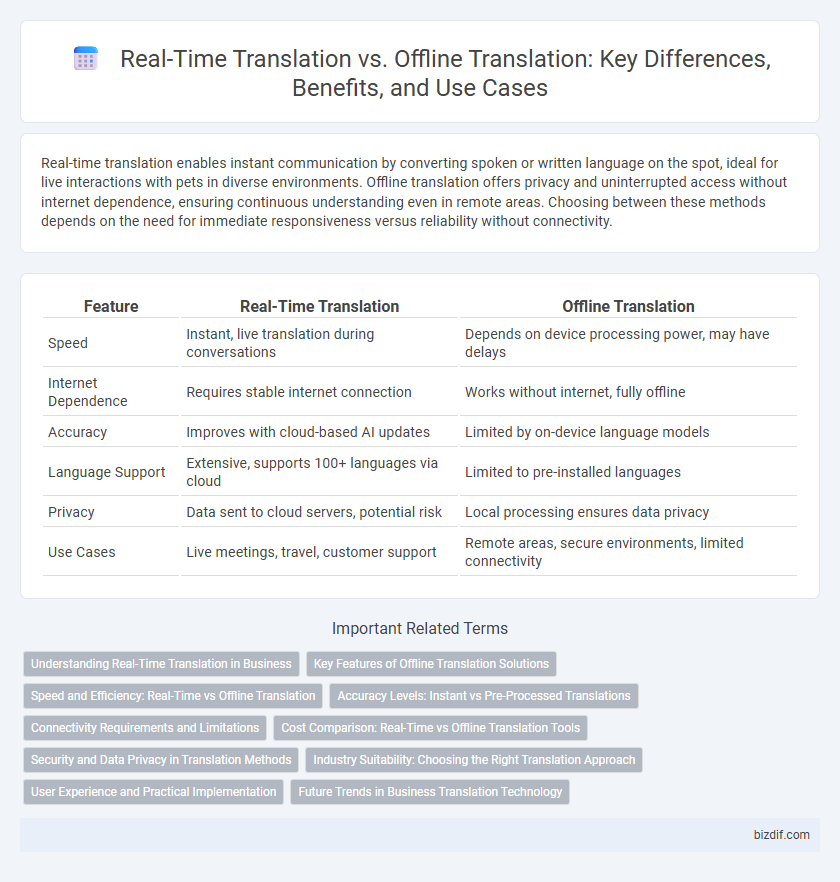Real-time translation enables instant communication by converting spoken or written language on the spot, ideal for live interactions with pets in diverse environments. Offline translation offers privacy and uninterrupted access without internet dependence, ensuring continuous understanding even in remote areas. Choosing between these methods depends on the need for immediate responsiveness versus reliability without connectivity.
Table of Comparison
| Feature | Real-Time Translation | Offline Translation |
|---|---|---|
| Speed | Instant, live translation during conversations | Depends on device processing power, may have delays |
| Internet Dependence | Requires stable internet connection | Works without internet, fully offline |
| Accuracy | Improves with cloud-based AI updates | Limited by on-device language models |
| Language Support | Extensive, supports 100+ languages via cloud | Limited to pre-installed languages |
| Privacy | Data sent to cloud servers, potential risk | Local processing ensures data privacy |
| Use Cases | Live meetings, travel, customer support | Remote areas, secure environments, limited connectivity |
Understanding Real-Time Translation in Business
Real-time translation enables businesses to facilitate instant communication across language barriers, enhancing global collaboration and customer engagement. Leveraging AI-powered tools, it supports live meetings, webinars, and customer service interactions without delays, improving efficiency and decision-making speed. Unlike offline translation, real-time solutions integrate seamlessly with digital platforms to provide continuous, context-aware language support essential for dynamic business environments.
Key Features of Offline Translation Solutions
Offline translation solutions offer key features such as accurate language processing without the need for an internet connection, ensuring privacy and data security. These tools often include downloadable language packs, enabling fast response times and consistent performance in remote or low-connectivity environments. Enhanced device compatibility and reduced latency make offline translators essential for reliable communication during travel or in sensitive situations.
Speed and Efficiency: Real-Time vs Offline Translation
Real-time translation enables instant language conversion by processing speech or text on the spot, significantly enhancing communication speed and user efficiency in dynamic environments. Offline translation relies on pre-downloaded language databases, offering reliable access without internet dependency but typically processing translations slower due to limited computational resources. Choosing between these methods depends on prioritizing immediate responsiveness with real-time systems or consistent availability with offline solutions, balancing speed and operational efficiency in translation tasks.
Accuracy Levels: Instant vs Pre-Processed Translations
Real-time translation offers instant language conversion, prioritizing speed over precision, which may lead to occasional inaccuracies due to limited context analysis. Offline translation leverages pre-processed linguistic data and advanced algorithms, resulting in higher accuracy by thoroughly analyzing syntax and semantics before output. Choosing between these methods depends on the need for immediate communication or precise, context-aware translation results.
Connectivity Requirements and Limitations
Real-time translation depends heavily on stable internet connectivity to access cloud-based language processing, enabling instant and accurate translations. Offline translation operates without internet access by relying on pre-downloaded language packs but may face limitations in vocabulary scope and contextual accuracy. Connectivity requirements influence usability, with real-time translation offering dynamic updates while offline methods ensure functionality in remote or restricted network environments.
Cost Comparison: Real-Time vs Offline Translation Tools
Real-time translation tools often incur higher costs due to continuous internet connectivity and cloud processing fees, while offline translation software generally requires a one-time purchase or subscription with no additional data charges. Businesses leveraging real-time translation benefit from instant, dynamic language updates and broader language support at the expense of ongoing operational expenses. Offline translation solutions offer cost predictability and enhanced privacy but may lack the extensive language databases and accuracy improvements typical of real-time services.
Security and Data Privacy in Translation Methods
Real-time translation often relies on cloud-based platforms, which can pose risks related to data interception and unauthorized access, raising significant security and privacy concerns. Offline translation tools, by processing data locally on the user's device, enhance data privacy by minimizing exposure to external servers and network vulnerabilities. Choosing offline translation methods ensures greater control over sensitive information, crucial for industries requiring stringent data protection compliance.
Industry Suitability: Choosing the Right Translation Approach
Real-time translation excels in industries requiring instant communication, such as customer support, live events, and international conferencing, enabling seamless interaction across language barriers. Offline translation is ideal for sectors like legal, medical, and technical fields where accuracy, data security, and confidentiality take priority over immediacy. Selecting the right translation approach depends on balancing the need for speed and accuracy with industry-specific requirements and operational constraints.
User Experience and Practical Implementation
Real-time translation delivers instant language conversion, enhancing user experience by facilitating seamless communication in dynamic environments such as live meetings or travel scenarios. Offline translation, while lacking immediate responsiveness, offers reliable performance without internet dependency, critical for privacy-sensitive or remote situations. Practical implementation requires balancing latency and accuracy for real-time systems, whereas offline solutions demand optimized on-device processing and regularly updated language databases.
Future Trends in Business Translation Technology
Real-time translation leverages AI-powered neural machine translation to provide instantaneous, context-aware language conversion, essential for global business communications and virtual meetings. Offline translation tools are increasingly incorporating advanced natural language processing and on-device AI to ensure privacy and reliability without internet dependency. Future trends emphasize hybrid models combining cloud-based real-time accuracy with offline security, enhancing multilingual collaboration and operational efficiency in international enterprises.
Real-Time Translation vs Offline Translation Infographic

 bizdif.com
bizdif.com